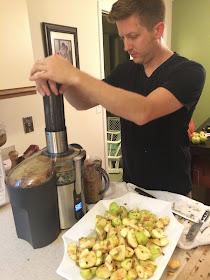After 5 years of wasting perfectly good apples, we were sure going to use up all we could this year. We did make the cobbler and it turned out great. But the tree was FULL of apples. We decided to go with Tom's idea to make hard cider, but it would be a regular somewhat sweet cider rather than sour. We spent an afternoon picking all of the apples we could, using two ladders and 1 monkey-like, tree-climber husband. I could not believe how many apples we picked and how many of them actually looked pretty good -- especially considering we had done nothing special to the tree and nothing to protect them against pests or disease (we will be careful about what we do going forward because we'd prefer to keep them organic).
 |
| Picking and sorting apples |
 |
| Tom monkeying around in the apple tree |
 |
| The harvest! We got a wheelbarrow plus a couple 5-gallon buckets full of apples from our tree. |
Most of the apples had spots on them, which I determined to be sooty blotch and flyspeck -- not harmful, but not something I want to eat, either. While making the cobbler, I discovered the spots come off pretty easily with some scrubbing. However, it took a long time just to hand scrub the apples for the cobbler -- there was no way we could hand scrub a wheelbarrow full! Fortunately, I had an idea. Somewhere recently somebody had showed us a video of this ingenious idea for how to peel a bag of potatoes in under a minute. It involves dumping the potatoes in a 5-gallon bucket, adding water, fitting a (NEW!!) toilet brush on the end of a drill and scrubbing away! We decided this might work for apples, not to peel them, but to scrub them clean. Tom gave it a try, and it worked like a charm! WAY, way easier than trying to do these by hand! We let the apples dry out in our sun room after the scrubbing, then transferred them back to several large containers.
 |
| Scrubbing the apples clean with a drill / toilet brush! |
 |
| Drying out the apples |
To make the cider, we first had to figure out how we were going to juice/press the apples. We didn't own a juicer. We do now. We ended up getting a Breville juicer from Amazon, and it worked great. We quartered the apples first and removed any bad apples or bad spots. Then, Tom ran all of the apple chunks through the juicer. From there, we dumped the juice into a 5-gallon bucket, but strained it through a mesh bag on the way in.
 |
| Quartered Apples - I did try to remove the stems. |
 |
| Our apple-juicing workstation |
 |
| Juicing! |
 |
| Dumped the juice in the bucket, through this mesh bag |
 |
| And the delicious apple solids go here -- and then get added to my garden for compost. |
 |
| Big pot 'o fresh juiced apple cider! |
 |
| Heat 'er up! |
Then, we transferred the pasteurized juice to a 5-gallon carboy. Yes, we had 5 full gallons of juice -- and still enough apples to perhaps make another gallon batch! We ended up filtering the juice through a finer mesh bag, as well, and we were glad that we did. There were still a LOT of fruit solids left that we strained out. Tom pitched the yeast (while I fell asleep on the couch after another late night of juicing!), and it's taking off! Now...we are contemplating getting a kegerator, and if I have my way, adding a little extra carbonation in the cider once it's done. Mad props to Tom, the Master Brewer, for figuring out how to juice, filter and ferment the cider all in very short order. If we're lucky, we'll have some hard cider available in time for this year's Halloween Party.





